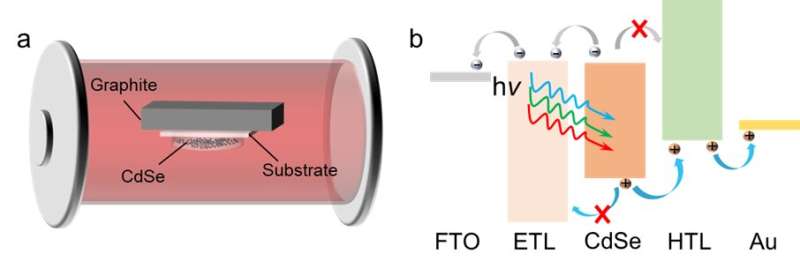Rapid preparation of CdSe thin-film solar cells

The silicon-based tandem solar cell is regarded as the most promising strategy to break the theoretical efficiency limit of single-junction Si solar cells. With Si-based tandem solar cells as the bottom cells, the optimal bandgap of top cells is 1.7 eV, which enables high efficiency of ~45% for two-junction tandem solar cells. III-V semiconductors/Si and perovskites/Si tandem solar cells have achieved high efficiency levels of ~30%, proving their feasibility. However, the stability challenges of perovskite and the high-cost problem of III-V semiconductors largely limit their wide applications. Exploring new stable, low-cost, and bandgap 1.7 eV photovoltaic materials is of great significance in science and broad prospects in technology.
Cadmium selenide (CdSe), a binary II-VI semiconductor, enjoys great potential in the application of Si-based tandem solar cells because of the suitable bandgap of ~1.7 eV, excellent optoelectronic properties, high stability, and low manufacturing cost. Nevertheless, the progress of CdSe thin-film solar cells remains as it was 30 years ago, and there are few systematic studies on CdSe thin-film solar cells in recent years.
Professor Tang Jiang and his team have proposed a method of rapid thermal evaporation (RTE) to obtain high-quality CdSe thin films and have designed CdSe thin-film solar cells. This study, entitled Rapid thermal evaporation for cadmium selenide thin-film solar cells, was published in Frontiers of Optoelectronics on Dec. 6, 2021.
In this study, the RTE was employed to deposit CdSe thin films, which demonstrate high crystal quality with large grain size and preferred crystal orientation. Meanwhile, the sharp absorption edge at 720 nm indicates CdSe thin films with a direct bandgap of 1.72 eV. The strong photoluminescence with full width at half maximum of 23 nm reveals the CdSe thin films with relatively few defects. Based on the high-quality CdSe thin films, a suitable electron transport layer (ETL) and hole transport layer (HTL) were introduced to construct CdSe solar cells. Finally, an efficiency of 1.88% was achieved by designing an optimal configuration of FTO/ZnO/CdS/CdSe/PEDOT/CuI.
This study developed, for the first time, a RTE method to deposit CdSe thin films and provided a systematical characterization of the optoelectric properties. Also, it demonstrated general rules for device design and optimization for CdSe solar cells. It also pointed out the advantages of CdSe thin film and its solar cells. In the future, CdSe solar cells are of high potential in Si-based tandem applications, and this is worthy of further study.
More information: Kanghua Li et al, Rapid thermal evaporation for cadmium selenide thin-film solar cells, Frontiers of Optoelectronics (2021). DOI: 10.1007/s12200-021-1217-1


















